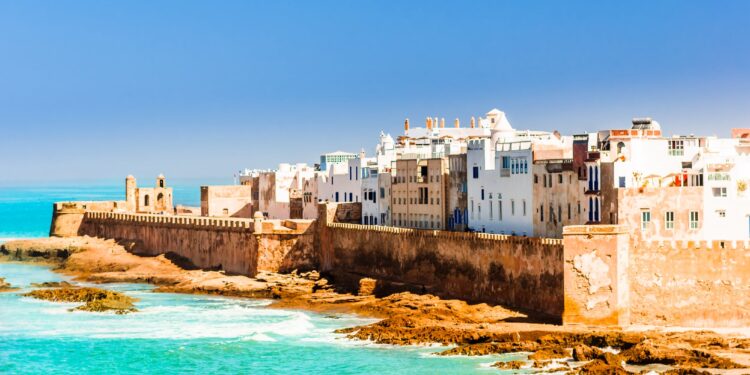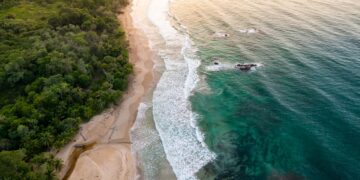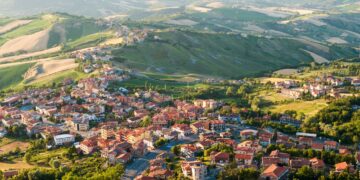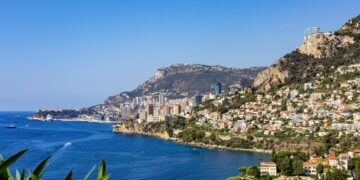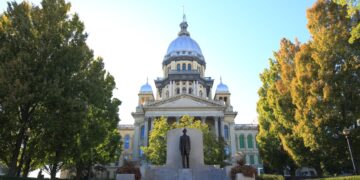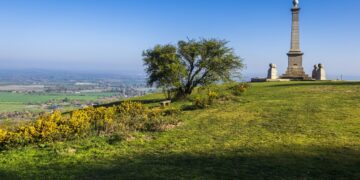From the bustling souks of Marrakech and the grandeur of Casablanca to the enchanting dunes of the Sahara Desert, Morocco is a melting pot of fascinating culture, history, and breathtaking landscapes. It’s no wonder that this North African gem has been the backdrop for numerous renowned films, TV shows, and literary works. Let’s embark on a cinematic journey through Morocco, exploring the famous filming locations and uncovering the hidden gems that contribute to the country’s cinematic allure.
Morocco and the Silver Screen: 10 Famous Films Shot in Morocco
Morocco’s diverse landscapes and exotic ambiance have long captivated filmmakers worldwide, providing the perfect settings for cinematic tales. Here are ten films that have beautifully showcased Morocco’s unique charm:
- “Casablanca” (1942) – This iconic film, albeit primarily shot in a Hollywood studio, is set in the city of Casablanca during World War II, etching the city’s name into cinematic history.
- “Lawrence of Arabia” (1962) – While the film is set in the Middle East, many of its desert scenes were actually filmed in Morocco’s vast Sahara Desert.
- “The Man Who Knew Too Much” (1956) – Alfred Hitchcock’s suspense-thriller features numerous scenes shot in Marrakech, showcasing the city’s vibrant markets and unique architecture.
- “The Mummy” (1999) – This action-adventure film used Morocco’s Sahara Desert as the backdrop for its ancient Egyptian setting.
- “Gladiator” (2000) – This epic historical drama features several scenes shot in Aí¯t Benhaddou, a fortified village that is now a UNESCO World Heritage site.
- “Babel” (2006) – This multi-narrative drama showcases the contrasting landscapes of Morocco, from its thriving cities to its remote desert regions.
- “Inception” (2010) – The Tangier medina served as the backdrop for some of the film’s thrilling action sequences.
- “Mission: Impossible – Rogue Nation” (2015) – The high-speed motorcycle chase scene was filmed on the winding roads of the Atlas Mountains.
- “Spectre” (2015) – The James Bond film features a thrilling helicopter fight scene shot in the Jemaa el-Fnaa square in Marrakech.
- “John Wick 3: Parabellum” (2019) – The film’s intense action sequences were filmed in various parts of Morocco, including Marrakech and the Sahara Desert.
These films not only highlight the diverse beauty of Morocco but also attest to the country’s significant contributions to global cinema.
Beyond the Big Screen: 5 TV Shows Set in Morocco
Morocco’s cinematic allure extends beyond films and into the realm of television. Here are five TV series that have utilized Morocco’s captivating scenery:
- “Game of Thrones” (2011-2019) – The fortified city of Aí¯t Benhaddou was transformed into the city of Yunkai in the popular fantasy series.
- “Prison Break” (2005-2017) – Several episodes from the series’ fifth season were filmed in Moroccan cities, including Casablanca and Ouarzazate.
- “Homeland” (2011-present) – The political thriller series used Morocco as a stand-in for Afghanistan and Pakistan in several episodes.
- “The Night Manager” (2016) – This British drama series features scenes shot in Marrakech, showcasing the city’s luxurious hotels and bustling markets.
- “Vikings: Valhalla” (2022-present) – The Netflix series has filmed some of its scenes in Morocco, using the country’s diverse landscapes to portray different locations.
Through these series, viewers can explore various facets of Moroccan culture, from its rich historical heritage to its vibrant modern cities.
Morocco through the Eyes of Children: 5 Animated Films Set in Morocco
Morocco’s cinematic appeal isn’t limited to live-action films and TV shows. The country’s rich culture and picturesque landscapes have also inspired various animated features. Here are five animated films that capture the spirit of Morocco:
- “The Prince of Egypt” (1998) – This animated musical, while set in Egypt, features desert scenes reminiscent of Morocco’s Sahara Desert.
- “Sinbad: Legend of the Seven Seas” (2003) – The animated adventure film showcases Moroccan-inspired cityscapes and architecture.
- “Aladdin” (1992 & 2019) – The fictional city of Agrabah in both the animated and live-action versions of Aladdin draws significant architectural inspiration from Moroccan design.
- “The Adventures of Tintin” (2011) – The animated film features a sequence set in Morocco, highlighting the country’s bustling markets and historic fortresses.
- “Zarafa” (2012) – This French animated film tells the tale of a young boy and a giraffe on an epic journey from Sudan to Paris, with key scenes set in Morocco.
These animated films celebrate Morocco’s unique blend of cultural richness and natural beauty, presenting audiences, particularly children, with fascinating stories and stunning visuals that embody the country’s charm.
From Pages to Reality: Famous Books Set in Morocco
The allure of Morocco extends into the realm of literature, with many authors drawing inspiration from its vibrant culture, rich history, and stunning landscapes. Here are some classic and contemporary books set in Morocco that will transport you to the heart of this mesmerizing country:
Classic:
- “The Sheltering Sky” by Paul Bowles – This classic novel, set in post-World War II Morocco, explores themes of alienation and existential despair.
- “Hideous Kinky” by Esther Freud – This semi-autobiographical novel tells the story of a young English girl and her experiences in Morocco during the 1960s.
- “Let It Come Down” by Paul Bowles – The novel provides a vivid portrayal of Tangier’s expatriate community in the late 1940s.
Contemporary:
- “The Tattooed Map” by Barbara Hodgson – This novel combines travelogue, mystery, and cultural exploration, set against the backdrop of Morocco.
- “The Caliph’s House: A Year in Casablanca” by Tahir Shah – This memoir chronicles the author’s experiences of moving from London to Casablanca.
- “Secret Son” by Laila Lalami – The novel explores themes of identity and class conflict in contemporary Morocco.
Whether you’re a fan of historical narratives or modern storytelling, these books offer a literary journey through Morocco’s multi-faceted persona, from its historic landmarks to its bustling cities.
Exploring Morocco’s Filming Locations – Where to Go
With its iconic landmarks and breathtaking landscapes, Morocco has long been a favored canvas for filmmakers. If you’re eager to trace the footsteps of movie stars and immerse yourself in the cinematic history of this vibrant country, here are some essential filming locations in Morocco you must visit:
- Aí¯t Benhaddou, near Ouarzazate – This fortified village has been featured in numerous films like “Gladiator” and “Game of Thrones”.
- Jemaa el-Fnaa, Marrakech – This bustling square, featured in “Spectre”, offers incredible food stalls, music, and street performances.
- Kasbah of the Udayas, Rabat – The beautiful kasbah provides panoramic views of the Atlantic Ocean and has served as a filming location for various films.
- Atlas Mountains – The winding roads of the Atlas Mountains were used as a backdrop for the high-speed motorcycle chase scene in “Mission: Impossible – Rogue Nation”.
- Sahara Desert – The vast Sahara Desert has appeared in numerous films, from “Lawrence of Arabia” to “The Mummy”.
Exploring these filming locations offers a unique blend of entertainment and sightseeing, allowing you to engage with Morocco’s film heritage while enjoying its many cultural and natural attractions.
Lodging in Morocco: From Budget to Luxury
Morocco, known for its refined culture and vibrant lifestyle, offers a diverse array of accommodations, from the ultra-luxurious to the charmingly economical.
Luxury:
- La Mamounia, Marrakech – This opulent hotel is a favorite among celebrities and known for its exquisite Moroccan architecture and stunning gardens.
- Kasbah Tamadot, Atlas Mountains – Owned by Richard Branson, this luxury resort offers breathtaking views of the Atlas Mountains.
- Riad Fí¨s, Fí¨s – This luxury hotel, located in the heart of Fí¨s, is known for its beautiful blend of traditional Moroccan design and modern amenities.
Budget:
- Equity Point Marrakech – Located near Jemaa el-Fnaa, this budget-friendly hostel offers comfortable accommodation with great facilities.
- Surf & Travel Camp, Taghazout – This budget-friendly surf camp offers shared and private rooms, perfect for those wanting to explore Morocco’s surf scene.
- Funky Fes, Fí¨s – Located near the Medina, this hostel offers budget-friendly rooms with a unique mix of modern and traditional Moroccan design.
Whether you’re looking for luxury accommodation or a budget-friendly option, Morocco offers a wide range of choices to suit every travel style.
Savoring Moroccan Cuisine: Where to Eat From Budget to Luxury
Morocco offers an array of dining options, from affordable street food to gourmet restaurants. Here are some places where you can savor Moroccan cuisine, from budget to luxury.
Budget:
- Street Food in Jemaa el-Fnaa, Marrakech – Known for its vibrant food stalls, Jemaa el-Fnaa offers a variety of affordable Moroccan dishes.
- Café Clock, Fí¨s – This popular café offers delicious Moroccan fusion dishes at reasonable prices.
- Fish Market, Essaouira – At this seaside market, you can choose your fish and have it grilled on the spot.
Luxury:
- Dar Yacout, Marrakech – This luxurious restaurant offers a fine dining experience of traditional Moroccan cuisine in an opulent setting.
- Rick’s Café, Casablanca – Inspired by the film “Casablanca”, this restaurant offers a blend of international and Moroccan dishes.
- Le Restaurant, Fí¨s – Located in Riad Fí¨s, this restaurant offers exquisite Moroccan cuisine with a modern twist, complemented by panoramic views of the Medina.
Whether you’re a foodie on a budget or a gourmet connoisseur seeking the finest culinary experiences, Morocco offers a dazzling array of gastronomic delights that reflect its rich cultural heritage.
Experience Morocco like the Stars: A Detailed Itinerary
Immerse yourself in the cinematic charm of Morocco with this five-day itinerary, exploring famous filming locations while delving into the country’s rich culture and history.
Day 1: Marrakech – The Red City
Begin your journey in Marrakech. Visit the bustling Jemaa el-Fnaa, explore the beautiful Majorelle Garden, and wander through the vibrant souks. Don’t forget to visit Koutoubia Mosque, the city’s iconic landmark.
Day 2: Marrakech – Atlas Mountains
Take a day trip to the Atlas Mountains, where you can enjoy hiking, visit traditional Berber villages, and admire the stunning landscape. This region served as the backdrop for several film sequences, including the high-speed motorcycle chase in “Mission: Impossible – Rogue Nation”.
Day 3: Ouarzazate – The Door of the Desert
Head to Ouarzazate, the film capital of Morocco. Visit the famous Aí¯t Benhaddou, a UNESCO World Heritage site that’s featured in numerous films like “Gladiator” and “Game of Thrones”. Also, explore the Atlas Film Studios, the world’s largest film studio in terms of land area.
Day 4: Fí¨s – The Cultural Heart of Morocco
Travel to Fí¨s, one of the world’s oldest cities. Explore the Fí¨s el Bali Medina, visit the historic Al-Qarawiyyin University and Mosque, and enjoy a delicious meal at Café Clock.
Day 5: Casablanca – The White City
End your journey in Casablanca, the economic hub of Morocco. Visit the Hassan II Mosque, the largest mosque in Africa, and enjoy a meal at Rick’s Café, inspired by the film “Casablanca”.
This itinerary provides a cinematic journey through Morocco, exploring the famous filming locations and immersing in the country’s rich culture and history.
The Mysterious Side of Morocco: Cryptid Legends and Curiosities
Beyond its cinematic allure, Morocco is also a land of legends and mysteries. One such legend is the Aisha Qandisha, one of the most feared entities in Moroccan folklore. Another is the tale of the Berber Lion, a cryptid believed to inhabit the Atlas Mountains.
These legends and cryptids add an element of mystery to Morocco’s cinematic locations, offering a rich source of inspiration for storytellers.
Off the Beaten Path: Hidden Gems in Morocco
While Morocco’s popular landmarks are frequently featured in films and TV shows, the country also offers numerous lesser-known locales that are equally cinematic.
- Chefchaouen – Known as the “Blue Pearl of Morocco”, this city offers a unique setting with its blue-rinsed houses and narrow alleyways.
- Dades Valley – Known as the “Road of a Thousand Kasbahs”, this valley offers stunning rock formations and ancient fortified villages.
- Paradise Valley – This hidden gem near Agadir offers a peaceful oasis with its palm-fringed river, rock pools, and waterfalls.
Whether you’re a filmmaker in search of unique locations or a traveler seeking less frequented spots, these hidden gems offer unique experiences and stunning views.
What to Pack for a Moroccan Adventure
Packing for a Moroccan adventure requires consideration of the country’s diverse climate and cultural norms. Here are some essentials:
- Comfortable Footwear – For exploring Morocco’s varied terrain, from the bustling streets of Marrakech to the sandy dunes of the Sahara.
- Versatile Clothing – Pack lightweight clothing for the day and warmer layers for cooler evenings. Remember to pack modest clothing to respect the local culture.
- Sun Protection – Don’t forget your sunglasses, sun hat, and sunscreen.
- Camera – To capture your own cinematic memories.
- Travel Guide and Map – For finding those famous filming locations and hidden gems.
With these packing tips, you’ll be well-prepared for your cinematic journey through Morocco.
Navigating Morocco: Transportation Tips
Navigating Morocco can be relatively easy, thanks to the country’s extensive transportation network. Here are some tips:
Rail – The Office National des Chemins de Fer (ONCF) operates a reliable and extensive rail network, connecting major cities such as Marrakech, Casablanca, Rabat, and Fí¨s.
Car – Renting a car can be a good option if you plan to explore rural areas. However, be prepared for Moroccan driving habits and traffic in cities.
Bus – For budget travelers, buses are the cheapest option for long-distance travel. Supratours and CTM are among the most reliable bus companies.
Petit Taxis – These small, usually red, yellow, or blue cars are an affordable way to get around within cities.
With these transportation options, you can explore Morocco’s cinematic locations with ease.
Travel Documents Needed for Visiting Morocco
When planning your trip to Morocco, it’s important to have the right travel documents:
- Passport – Your passport should be valid for at least six months beyond your planned date of departure.
- Visa – Depending on your nationality, you may need a visa to enter Morocco. Check with the Moroccan Embassy or Consulate in your country for specific requirements.
- Travel Insurance – It’s recommended to have travel insurance that covers medical expenses, trip cancellation, and lost luggage.
- International Driving Permit – If you plan to rent a car, an International Driving Permit (IDP) is recommended.
Having these documents in order will help ensure a smooth journey to the heart of cinematic Morocco.
Conclusion: Your Ultimate Guide to Morocco’s Cinematic Landscape
From the legendary city of Casablanca to the fortified village of Aí¯t Benhaddou, Morocco offers a cinematic journey like no other. Whether you’re a film buff, a TV series enthusiast, a book lover, or simply a traveler in search of unique experiences, this guide provides a comprehensive overview of Morocco’s cinematic landscape. Embark on a journey through Morocco’s famous films, TV shows, books, and discover the hidden gems that make this country a filmmaker’s dream. Bon voyage!


